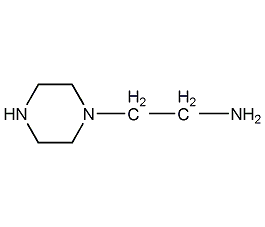N-(2-Aminoethyl)piperazine N-(2-Aminoethyl)piperazine


Structural formula
| Business number | 03SY |
|---|---|
| Molecular formula | C6H15N3 |
| Molecular weight | 129.20 |
| label |
N-aminoethylpiperazine, Aminoethylpiperazine, Aminoethyl-p-diazepine, 2-Piperazinoethylamine, Surfactant, corrosion inhibitors, Hardener |
Numbering system
CAS number:140-31-8
MDL number:MFCD00005971
EINECS number:205-411-0
RTECS number:TK8050000
BRN number:104363
PubChem number:24890984
Physical property data
1. Properties: Colorless or light yellow transparent liquid.
2. Density (g/mL, 25/4℃): 0.9853Colorless or light yellow transparent liquid. 0.989
3. Relative vapor density (g/mL, air=1): Undetermined
4. Melting point (ºC): Undetermined
5. Boiling point (ºC, normal pressure): 210~230
6. Boiling point (ºC, 5.2kPa): Not available Determined
7. Refractive index: 1.500
8. Flash point (ºC): 93
9. Specific rotation (º): Undetermined
p>
10. Autoignition point or ignition temperature (ºC): Undetermined
11. Vapor pressure (kPa, 25ºC): Undetermined
12. Saturated vapor pressure (kPa, 60ºC): Undetermined
13. Heat of combustion (KJ/mol): Undetermined
14. Critical temperature (ºC): Undetermined
15. Critical pressure (KPa): Undetermined
16. Log value of oil-water (octanol/water) partition coefficient: Undetermined
17. Explosion upper limit (%, V /V): Undetermined
18. Lower explosion limit (%, V/V): Undetermined
19. Solubility: Soluble in water.
Toxicological data
Acute toxicity:
Oral LD50 1500mg/kg(ckn)
2140ul/kg(rat)
Skin LD50 880ul/kg(rbt)
Skin irritation severe 5mg/24H(rbt)
Main irritating effects:
On the skin: on the skin and mucous membranes Causes corrosive effects on skin and mucous membranes
Irritation.
On eyes:
Strong corrosive effect
IrritationThe influence of �.
Sensitization: May cause sensitization through skin contact.
Ecological data
General Notes
Do not allow this product to come into contact with groundwater, waterways or sewage systems.
Water hazard class 2 (German Regulation) (self-assessment via list) The substance is hazardous to water.
Even extremely small amounts of product leaching into the ground can pose a hazard to drinking water
Do not discharge materials into the surrounding environment without government permission.
Hazardous to organic matter in the water.
Molecular structure data
1. Molar refractive index: 38.68
2. Molar volume (cm3/mol): 129.1
3. Isotonic specific volume (90.2K): 324.9
4. Surface tension (dyne/cm): 40.0
5. Polarizability (10-24cm3): 15.33
Compute chemical data
1. Reference value for hydrophobic parameter calculation (XlogP): -1.3
2. Number of hydrogen bond donors: 2
3. Number of hydrogen bond acceptors: 3
p>
4. Number of rotatable chemical bonds: 2
5. Number of tautomers: none
6. Topological molecule polar surface area 41.3
7. Number of heavy atoms: 9
8. Surface charge: 0
9. Complexity: 68.7
10. Number of isotope atoms: 0
11. Determine the number of atomic stereocenters: 0
12. Uncertain number of atomic stereocenters: 0
13. Determine the number of chemical bond stereocenters: 0
14. Number of uncertain chemical bond stereocenters: 0
15. Number of covalent bond units: 1
Properties and stability
Storage method
Store sealed and protected from light.
Synthesis method
1. This product is a by-product of the reaction of dichloroethane and ammonia to produce ethylenediamine products. Raw material consumption quota: dichloroethane 2100kg/t, liquid ammonia 620kg/t, caustic soda (42%) 4143kg/t.
2.The by-product produced when dichloroethane and ammonia are reacted to produce ethylenediamine and polyamines, which are distilled and Non-aminoethylpiperazine is prepared after decolorization.
Purpose
1. Surfactant. Corrosion inhibitors. Epoxy resin hardener. Drug intermediates. Anthelmintics.
2.Used as a curing agent for epoxy resin, it is easy to use, allows a wide range of addition amounts, low shrinkage after curing, and low toxicity Features. The reference dosage is 20 to 23 parts by mass, and the curing conditions are RT/3h+200℃/1h. The thermal deformation temperature of the cured product is 110~120℃. It is also used as a modifier for alkyd resin and as a raw material for manufacturing polyurethane resin, organic pigments and pharmaceuticals.
